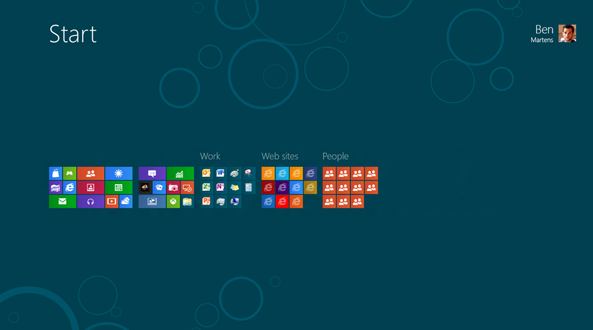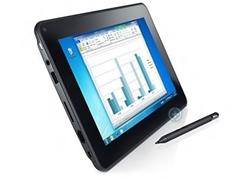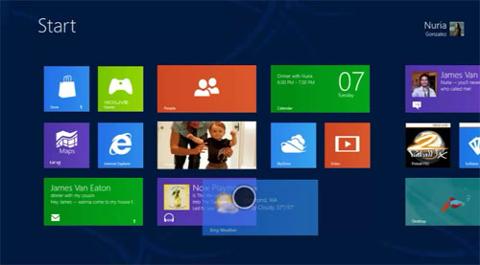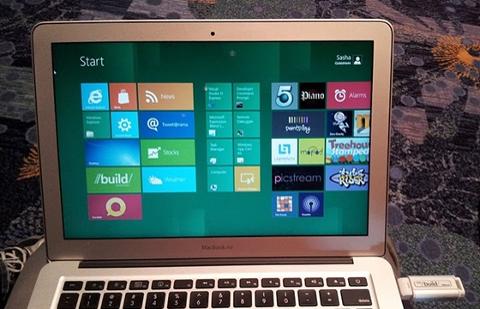 Windows 8.[/caption] Microsoft’s preview version of Windows 8.1 Enterprise adds a variety of patches and redesigns. Like the commercial version of the operating system, Windows 8.1 Enterprise (which is designed for commercial workstations and servers) includes the ability to boot directly to the desktop, a reorganized applications screen, and other features. There are new security features, such as the ability to remotely delete corporate data on an end-user's PC. Support for virtual desktop infrastructures also gets a boost, along with the ability to cache data from remote servers to improve performance for applications being used in remote locations and connected via comparatively slow WAN links or sluggish software. Workplace Join, for example, can set up a temporary or limited membership in a particular corporate domain, to give users mobile or visiting users access to corporate resources without locking them into a single domain. Work Folders automatically syncs corporate data on a laptop back to the corporate datacenter; Open MDM is client software designed to link Windows 8.1 to mobile-device management software using the Open Mobile Alliance Device Management (OMA-DM) API. It also has ease-of-use features such as near-field communications (NFC) links to printers, monitors or presentation displays, and direct connections to WiFi enabled printers. On top of that, Windows 8.1 Enterprise comes with better mobile and mobile-security features, including a range of VPN clients, support for wireless connectors built into the chipset rather than as separate components, a tethering feature to allow a laptop to act more easily as a WiFi hotspot, and a setting that automatically triggers a VPN connection in certain locations that might be considered unsafe otherwise. Some of the security improvements are significant enough to be unusual in a point release. Remote Business Data Removal allows companies to wipe machines that were lost or stolen; full-disk encryption is available out of the box; Internet Explorer and Windows Defender both got improvements in security against rogue code or malware. Device Lockdown is designed to define the situations in which a particular app is allowed to run. A Windows Store application designed for kids in an educational setting can be designed to run only in those environments or with pre-set security settings, for example. Windows 8 has grown slowly since it was launched, reaching market share of only 19.43 percent in June, according to some figures, compared to 44.4 percent for the aging Windows 7. While the list of BYOD- and remote-work-friendly features could make managing Win8 machines much easier, the actual impact will depend more on how well those features test within corporate application- and network infrastructures. Image: Microsoft
Windows 8.[/caption] Microsoft’s preview version of Windows 8.1 Enterprise adds a variety of patches and redesigns. Like the commercial version of the operating system, Windows 8.1 Enterprise (which is designed for commercial workstations and servers) includes the ability to boot directly to the desktop, a reorganized applications screen, and other features. There are new security features, such as the ability to remotely delete corporate data on an end-user's PC. Support for virtual desktop infrastructures also gets a boost, along with the ability to cache data from remote servers to improve performance for applications being used in remote locations and connected via comparatively slow WAN links or sluggish software. Workplace Join, for example, can set up a temporary or limited membership in a particular corporate domain, to give users mobile or visiting users access to corporate resources without locking them into a single domain. Work Folders automatically syncs corporate data on a laptop back to the corporate datacenter; Open MDM is client software designed to link Windows 8.1 to mobile-device management software using the Open Mobile Alliance Device Management (OMA-DM) API. It also has ease-of-use features such as near-field communications (NFC) links to printers, monitors or presentation displays, and direct connections to WiFi enabled printers. On top of that, Windows 8.1 Enterprise comes with better mobile and mobile-security features, including a range of VPN clients, support for wireless connectors built into the chipset rather than as separate components, a tethering feature to allow a laptop to act more easily as a WiFi hotspot, and a setting that automatically triggers a VPN connection in certain locations that might be considered unsafe otherwise. Some of the security improvements are significant enough to be unusual in a point release. Remote Business Data Removal allows companies to wipe machines that were lost or stolen; full-disk encryption is available out of the box; Internet Explorer and Windows Defender both got improvements in security against rogue code or malware. Device Lockdown is designed to define the situations in which a particular app is allowed to run. A Windows Store application designed for kids in an educational setting can be designed to run only in those environments or with pre-set security settings, for example. Windows 8 has grown slowly since it was launched, reaching market share of only 19.43 percent in June, according to some figures, compared to 44.4 percent for the aging Windows 7. While the list of BYOD- and remote-work-friendly features could make managing Win8 machines much easier, the actual impact will depend more on how well those features test within corporate application- and network infrastructures. Image: Microsoft Enterprise Update for Windows 8 Pumps Up BYOD, Remote Work
[caption id="attachment_11298" align="aligncenter" width="593"]  Windows 8.[/caption] Microsoft’s preview version of Windows 8.1 Enterprise adds a variety of patches and redesigns. Like the commercial version of the operating system, Windows 8.1 Enterprise (which is designed for commercial workstations and servers) includes the ability to boot directly to the desktop, a reorganized applications screen, and other features. There are new security features, such as the ability to remotely delete corporate data on an end-user's PC. Support for virtual desktop infrastructures also gets a boost, along with the ability to cache data from remote servers to improve performance for applications being used in remote locations and connected via comparatively slow WAN links or sluggish software. Workplace Join, for example, can set up a temporary or limited membership in a particular corporate domain, to give users mobile or visiting users access to corporate resources without locking them into a single domain. Work Folders automatically syncs corporate data on a laptop back to the corporate datacenter; Open MDM is client software designed to link Windows 8.1 to mobile-device management software using the Open Mobile Alliance Device Management (OMA-DM) API. It also has ease-of-use features such as near-field communications (NFC) links to printers, monitors or presentation displays, and direct connections to WiFi enabled printers. On top of that, Windows 8.1 Enterprise comes with better mobile and mobile-security features, including a range of VPN clients, support for wireless connectors built into the chipset rather than as separate components, a tethering feature to allow a laptop to act more easily as a WiFi hotspot, and a setting that automatically triggers a VPN connection in certain locations that might be considered unsafe otherwise. Some of the security improvements are significant enough to be unusual in a point release. Remote Business Data Removal allows companies to wipe machines that were lost or stolen; full-disk encryption is available out of the box; Internet Explorer and Windows Defender both got improvements in security against rogue code or malware. Device Lockdown is designed to define the situations in which a particular app is allowed to run. A Windows Store application designed for kids in an educational setting can be designed to run only in those environments or with pre-set security settings, for example. Windows 8 has grown slowly since it was launched, reaching market share of only 19.43 percent in June, according to some figures, compared to 44.4 percent for the aging Windows 7. While the list of BYOD- and remote-work-friendly features could make managing Win8 machines much easier, the actual impact will depend more on how well those features test within corporate application- and network infrastructures. Image: Microsoft
Windows 8.[/caption] Microsoft’s preview version of Windows 8.1 Enterprise adds a variety of patches and redesigns. Like the commercial version of the operating system, Windows 8.1 Enterprise (which is designed for commercial workstations and servers) includes the ability to boot directly to the desktop, a reorganized applications screen, and other features. There are new security features, such as the ability to remotely delete corporate data on an end-user's PC. Support for virtual desktop infrastructures also gets a boost, along with the ability to cache data from remote servers to improve performance for applications being used in remote locations and connected via comparatively slow WAN links or sluggish software. Workplace Join, for example, can set up a temporary or limited membership in a particular corporate domain, to give users mobile or visiting users access to corporate resources without locking them into a single domain. Work Folders automatically syncs corporate data on a laptop back to the corporate datacenter; Open MDM is client software designed to link Windows 8.1 to mobile-device management software using the Open Mobile Alliance Device Management (OMA-DM) API. It also has ease-of-use features such as near-field communications (NFC) links to printers, monitors or presentation displays, and direct connections to WiFi enabled printers. On top of that, Windows 8.1 Enterprise comes with better mobile and mobile-security features, including a range of VPN clients, support for wireless connectors built into the chipset rather than as separate components, a tethering feature to allow a laptop to act more easily as a WiFi hotspot, and a setting that automatically triggers a VPN connection in certain locations that might be considered unsafe otherwise. Some of the security improvements are significant enough to be unusual in a point release. Remote Business Data Removal allows companies to wipe machines that were lost or stolen; full-disk encryption is available out of the box; Internet Explorer and Windows Defender both got improvements in security against rogue code or malware. Device Lockdown is designed to define the situations in which a particular app is allowed to run. A Windows Store application designed for kids in an educational setting can be designed to run only in those environments or with pre-set security settings, for example. Windows 8 has grown slowly since it was launched, reaching market share of only 19.43 percent in June, according to some figures, compared to 44.4 percent for the aging Windows 7. While the list of BYOD- and remote-work-friendly features could make managing Win8 machines much easier, the actual impact will depend more on how well those features test within corporate application- and network infrastructures. Image: Microsoft
 Windows 8.[/caption] Microsoft’s preview version of Windows 8.1 Enterprise adds a variety of patches and redesigns. Like the commercial version of the operating system, Windows 8.1 Enterprise (which is designed for commercial workstations and servers) includes the ability to boot directly to the desktop, a reorganized applications screen, and other features. There are new security features, such as the ability to remotely delete corporate data on an end-user's PC. Support for virtual desktop infrastructures also gets a boost, along with the ability to cache data from remote servers to improve performance for applications being used in remote locations and connected via comparatively slow WAN links or sluggish software. Workplace Join, for example, can set up a temporary or limited membership in a particular corporate domain, to give users mobile or visiting users access to corporate resources without locking them into a single domain. Work Folders automatically syncs corporate data on a laptop back to the corporate datacenter; Open MDM is client software designed to link Windows 8.1 to mobile-device management software using the Open Mobile Alliance Device Management (OMA-DM) API. It also has ease-of-use features such as near-field communications (NFC) links to printers, monitors or presentation displays, and direct connections to WiFi enabled printers. On top of that, Windows 8.1 Enterprise comes with better mobile and mobile-security features, including a range of VPN clients, support for wireless connectors built into the chipset rather than as separate components, a tethering feature to allow a laptop to act more easily as a WiFi hotspot, and a setting that automatically triggers a VPN connection in certain locations that might be considered unsafe otherwise. Some of the security improvements are significant enough to be unusual in a point release. Remote Business Data Removal allows companies to wipe machines that were lost or stolen; full-disk encryption is available out of the box; Internet Explorer and Windows Defender both got improvements in security against rogue code or malware. Device Lockdown is designed to define the situations in which a particular app is allowed to run. A Windows Store application designed for kids in an educational setting can be designed to run only in those environments or with pre-set security settings, for example. Windows 8 has grown slowly since it was launched, reaching market share of only 19.43 percent in June, according to some figures, compared to 44.4 percent for the aging Windows 7. While the list of BYOD- and remote-work-friendly features could make managing Win8 machines much easier, the actual impact will depend more on how well those features test within corporate application- and network infrastructures. Image: Microsoft
Windows 8.[/caption] Microsoft’s preview version of Windows 8.1 Enterprise adds a variety of patches and redesigns. Like the commercial version of the operating system, Windows 8.1 Enterprise (which is designed for commercial workstations and servers) includes the ability to boot directly to the desktop, a reorganized applications screen, and other features. There are new security features, such as the ability to remotely delete corporate data on an end-user's PC. Support for virtual desktop infrastructures also gets a boost, along with the ability to cache data from remote servers to improve performance for applications being used in remote locations and connected via comparatively slow WAN links or sluggish software. Workplace Join, for example, can set up a temporary or limited membership in a particular corporate domain, to give users mobile or visiting users access to corporate resources without locking them into a single domain. Work Folders automatically syncs corporate data on a laptop back to the corporate datacenter; Open MDM is client software designed to link Windows 8.1 to mobile-device management software using the Open Mobile Alliance Device Management (OMA-DM) API. It also has ease-of-use features such as near-field communications (NFC) links to printers, monitors or presentation displays, and direct connections to WiFi enabled printers. On top of that, Windows 8.1 Enterprise comes with better mobile and mobile-security features, including a range of VPN clients, support for wireless connectors built into the chipset rather than as separate components, a tethering feature to allow a laptop to act more easily as a WiFi hotspot, and a setting that automatically triggers a VPN connection in certain locations that might be considered unsafe otherwise. Some of the security improvements are significant enough to be unusual in a point release. Remote Business Data Removal allows companies to wipe machines that were lost or stolen; full-disk encryption is available out of the box; Internet Explorer and Windows Defender both got improvements in security against rogue code or malware. Device Lockdown is designed to define the situations in which a particular app is allowed to run. A Windows Store application designed for kids in an educational setting can be designed to run only in those environments or with pre-set security settings, for example. Windows 8 has grown slowly since it was launched, reaching market share of only 19.43 percent in June, according to some figures, compared to 44.4 percent for the aging Windows 7. While the list of BYOD- and remote-work-friendly features could make managing Win8 machines much easier, the actual impact will depend more on how well those features test within corporate application- and network infrastructures. Image: Microsoft 

